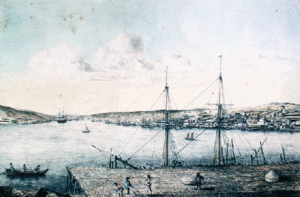Fort William, Newfoundland
| Fort William | |
|---|---|
| St. John's, Newfoundland | |

View from Fort William
|
|
| Type | Fortress, garrisoned and armoured. |
| Site history | |
| Built | 1698 |
| In use | 1700 - 1871 |
| Battles/wars |
King William's War 1689-1697 |
| Official name | Fort William National Historic Site of Canada |
| Designated | 1952 |
| Garrison information | |
| Garrison | English |
King William's War 1689-1697
Queen Anne's War 1702-13
King George's War 1743-48
French and Indian War 1756-63
Fort William was a fort in St. John's built in 1698 to protect English interests in Newfoundland, primarily against French opposition. It was the original headquarters of the British garrison in Newfoundland. A second fort, known as Fort George was situated at the east end of the harbour connected by a subterranean passage with Fort William. On the south side of the Narrows, there was a third fortification called the Castle.
The Fort was demolished in 1881 to make room for a railway yard, the barracks being used as the station. This was demolished in 1910 and urban development now occupies the site.
Fort William was designated a National Historic Site of Canada in 1952. As there are no visible remains, the site is marked by a Historic Sites and Monuments Board plaque located on a retaining wall at the corner of Cavendish Square and Duckworth Street in downtown St. John’s
The Second Anglo-Dutch War brought about a renewal of naval warfare with Holland and Newfoundland. Meeting little opposition, a Dutch fleet captured St. John's in 1665, burning shipping and property on shore. Still without naval or military defences, the English merchants of St. John's did what they could for their own defence. After the Dutch attack Christopher Martin, a Devon merchant captain, built and maintained defensive batteries, King William’s Fort, at the entrance to the harbour at his own expense. Martin landed six cannon from his vessel, the Elias Andrews, and constructed an earthen breastwork and battery near chain Rock commanding the Narrows leading into the harbour.
During the Third Anglo-Dutch War, in 1673 Martin, with fewer than thirty men, successfully defended the harbour from a second Dutch attack and a separate raid by four pirate vessels.
...
Wikipedia
